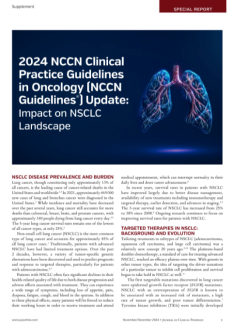Clearing the Air: Exploring Payer Pathway Breadth and Depth
Key Findings
- Payer clinical pathway programs show similar breadth in the tumors included in their respective programs. All four programs evaluated include a pathway for every tumor with a US annual incidence rate of > 20 000, with the exception of brain and nervous system cancers. Differences in breadth occur in tumors with relatively low incidence rates.
- Payer-sponsored clinical pathway programs exhibit significant variability in the depth of the pathway for a given tumor. eviCore’s program is the “shallowest” program, Optum’s and Carelon’s programs are in the middle, while Evolent’s program is the “deepest.”
Background
In Q4 2024, HMP Market Access Insights (MAI) conducted desktop research and an interview program examining prominent payer- and provider-developed clinical pathway programs. The purpose of our research was to perform a comprehensive analysis on the values, structures, and processes underpinning these programs. Additionally, we sought to clarify topics where substantial confusion or inconsistency exist among stakeholder groups. This column highlights one of the clarifying analyses we conducted as part of that research.
Study Approach
As part of the MAI research on oncology clinical pathway programs this year, one challenge our team encountered was sorting the myriads of languages pathway developers use to describe their clinical pathway programs. How it is that all payer programs claim to cover 90% of tumors, yet we consistently hear clinical pathway users criticize these for their brevity? How do we reconcile this with what we heard at the 2024 Clinical Pathways Congress, where payer clinical pathway developers affirmed that their programs offer a similar level of detail to provider-developed pathways? Notably, Elsevier’s ClinicalPath boasts over 2500 pathways, while the highest number we heard from a payer was 50.
We suspected that many of the discrepancies stemmed from definitional differences and organizations employing similar language to describe highly variable programs. To better understand these variations, we conducted an analysis on the self-reported breadth (eg, the number of tumors or patients eligible for their pathway) and depth (eg, the level of detail within a specific tumor) of payer pathway programs, to identify key differences, and gain insight into the criticisms they have faced.
We created a unified framework to analyze the clinical pathway programs developed by Optum, Carelon, eviCore, and Evolent. For breadth, we standardized tumor pathways into a consistent framework of 24 tumor categories. For depth, we quantified the distinct biomarkers, lines of therapy, and other factors important to defining treatment strategies for each tumor to assess the level of detail in each program.
Tumor Breadth
Most differences in tumor representation definitions come from variations in how payers categorize tumors, rather than differences in the tumors for which they propose treatments in. For example, the eviCore, Carelon, and Optum programs list small cell lung cancer (SCLC) and non-small cell lung cancer (NSCLC) as separate categories. In contrast, Evolent—despite having the broadest representation by our analysis—groups both under a single “lung cancer” category, with SCLC and NSCLC identified as subcategories.
We observed categorization differences across several other tumors as well, including lymphoma, breast, and gastrointestinal cancers. However, our analysis revealed that payer pathway programs share more similarities than differences (Table).


Pathway Depth
According to our analysis, the depth of payer clinical pathway programs varies significantly across the Optum, Carelon, eviCore, and Evolent programs. The deepest clinical pathway program includes three times as many “branches” as the “shallowest” (Figure 1). The clinical pathways for renal clear cell carcinoma illustrate this variability quite clearly. Among the four possible levels of pathway depth, the payer programs examined utilized three. eviCore’s clinical pathway program is only one “branch” deep, Carelon’s contains two, and Optum and Evolent contain all four levels (Figure 2).


Aligning Payer Clinical Pathway Programs With Clinical Practice Standards in Oncology
Based on conversations with physicians, practice managers, and clinical pathways developers as part of our 2024-2025 Oncology Pathways Report, we believe that a clinical pathway’s depth is critical when clinical leaders are frustrated with the payer programs. If physicians are expected to use a combination of genetic markers, lines of therapy, and other patient/tumor profiling characteristics in determining treatment recommendations, then payer pathway tools also need to align to current treatment paradigms.
When a clinical pathway program omits one of the patient/ tumor variables physicians use in their treatment assessment, the pathway flips from being an assistive tool to a hindrance to timely care. While all payer pathway programs cover most of the same tumors, the large variation in pathway depth can explain why oncology practice leaders express frustration with payer clinical pathway programs and why they are frequently seen as another form of payer utilization management.
Why This Matters
Payer clinical pathways are just one of many points of interaction between payers and manufacturers. As manufacturers seek to optimize their market access strategies, it is important to understand key differences between programs to help leaders determine if pathways should be a key part of their access strategy.
Variations in payer pathway breadth and depth mean that a given product may not be impacted by all pathways. Understanding these dimensions of payer pathway programs can help manufacturers develop tumor-specific strategies and refine their efforts to the pathways that are most likely to impact their brand.
Want to learn more? Reach out to our team for access to our full pathways report, where we outline other key features integral to developing a successful pathway access strategy and quantify the impact it can have on a brand’s market share.

















